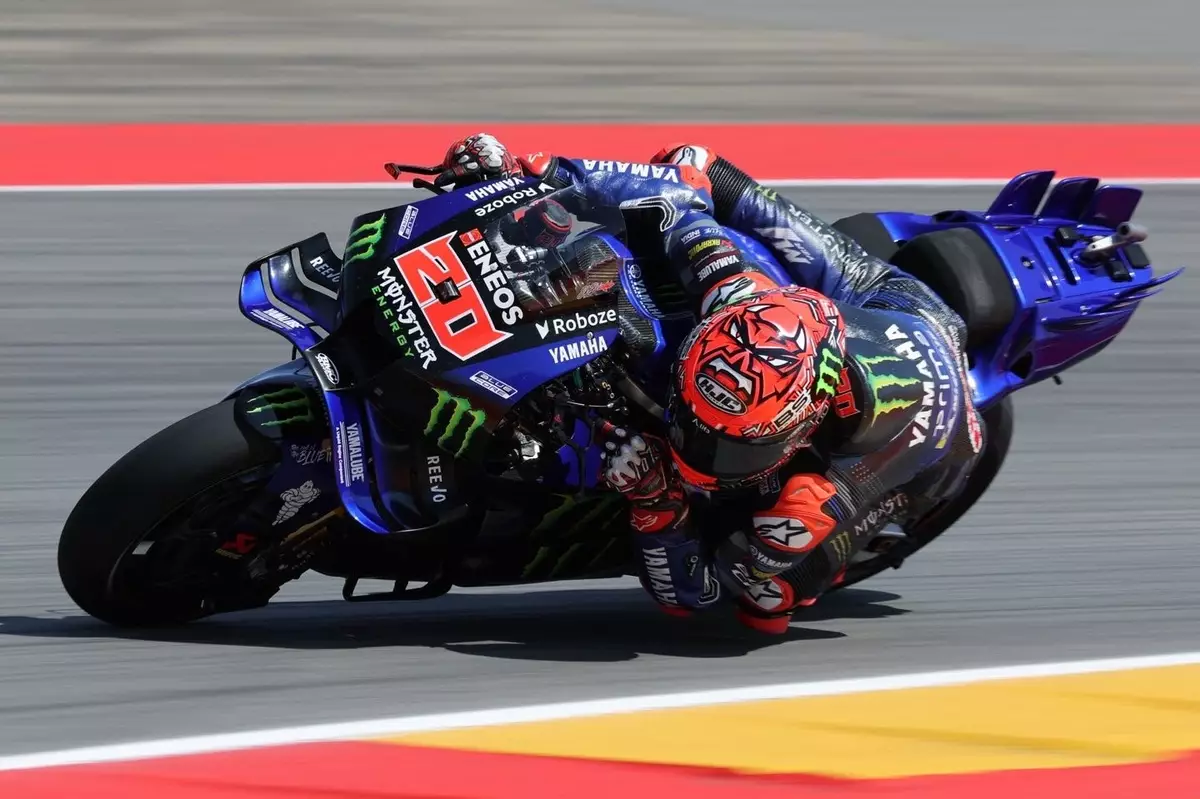Yamaha has long been hailed as a dominant force in the realm of MotoGP, but their recent shortcomings at the Aragon circuit laid bare a troubling reality – a critical grip deficiency plaguing their YZR-M1 machine. The low-grip conditions of the track turned into a harsh spotlight, exposing the inherent weaknesses of Yamaha’s engineering. For rider Fabio Quartararo, this became a gauntlet, transforming a promising weekend into a string of frustrations that seemed to echo throughout the pit lane.
As the practice sessions unfolded, it was evident that Quartararo, the 2021 MotoGP world champion, was grappling with an unpredictable machine. The rear of his Yamaha exhibited a disconcerting tendency to snap and jump at every corner exit. This was not just a minor inconvenience but a significant impediment to his performance. In stark contrast to competitors like Brad Binder on his KTM, Quartararo’s Yamaha was, shockingly, the slowest through the speed trap, trailing by nearly 10 kilometers per hour. The inability to lay down power on the tarmac starkly illustrated Yamaha’s urgent need for a breakthrough in grip management.
A Frustrated Champion
Watching Quartararo on the track during Friday practice, the frustration was palpable. His gestures conveyed an anxious blend of urgency and dissatisfaction, as he fought an uphill battle against the limitations of his bike. Upon exiting the session, he opted for solitude over immediate debriefs – a clear indication of his need to process the day’s events. Yet, Quartararo retained a hint of humor, making light of the situation when addressing the media, showcasing his resilience in the face of adversity.
“Almost made the pole position… on the other side of the grid,” he joked, yet his tone bore the weight of genuine concern. As he reflected on a dismal day marred by erratic electronic performance and troubling grip issues, it was evident that the situation was more serious than the light-hearted banter suggested. Quartararo admitted the unpredictability of the bike’s behavior was particularly dangerous, especially when he was fully leaned over in corners and unsure if he would hold onto the rear or face a sudden slide.
Technical Dilemmas and Team Insights
Yamaha’s struggles were not isolated to Quartararo, as teammate Alex Rins shared a similar fate, finishing the session in 15th place, a reflection of a broader dilemma. Yamaha’s team director, Massimo Meregalli, echoed the sentiments of frustration while providing insight into the challenges his riders faced. The crux of the issue, as highlighted by Meregalli, lay in the rear grip or lack thereof, which inevitably caused a loss of control whenever they pushed the limits of performance.
“It’s the rear grip,” Meregalli stated, signifying the collective challenge faced not just by Quartararo but also by Rins. The rising temperatures exacerbated the issues further, diminishing grip when it was most needed. For the Yamaha team, translating practice hurdles into race-day solutions became an urgent priority. Despite initial optimism following FP1, the harsh reality set in as conditions shifted unfavorably across the sessions.
The Path Forward
As Yamaha enters critical days of preparation leading up to the race, Quartararo and the team are left to ponder the complexities of the right setup concerning tire changes and electronics. This conundrum is not just a technical challenge; it embodies the spirit of racing itself – the relentless pursuit of perfection amidst adversity. Quartararo’s candid revelations about the bike’s set-up being “good” yet mysteriously negatively affected upon tire changes signal that underlying issues lie within the synergy of components rather than merely the setup alone.
The dialogue surrounding Yamaha’s plight is indicative of a much larger narrative within the MotoGP environment – a demonstration of how even the legendary names can find themselves clawing back from vulnerabilities wreaked by the unforgiving nature of motorsport. It’s no longer just about achieving top speeds; it revolves around mastering grip, control, and the capability to manipulate these elements into a cohesive performance.
Overcoming these obstacles requires not only technical adjustments but crafting a robust strategic approach moving forward. The Aragon circuit has served as an intensive learning ground for Yamaha, laying bare flaws and firing up the urgency for innovation. As Quartararo prepares to confront the next challenges on the grid, a renewed determination will be paramount in shifting Yamaha’s fortunes back into a winning trajectory.

